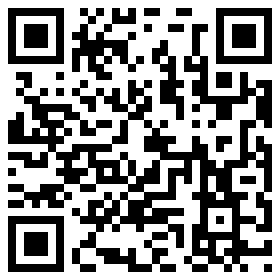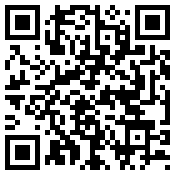How does exchanging health information work to improve health? Getting the facts about your favorite subject (you!) is extraordinarily motivating. It is the reason why actionable communications like those embedded in effective patient outreach systems work. Here's a nice review of the psychology by Joe Kvedar at Connected Health: Self-Quantification as a Driver of Behavior Change
A personal look at clinical decision support -- using individual information (lab test results, clinical findings, prescriptions, administrative data, etc.) to engage patients, improve individual care, enhance population health, and make health care safer, faster, cheaper and more effective.
Wednesday, November 23, 2011
Wednesday, September 21, 2011
QR Codes for communicating with patients...
QR Codes are those funny little black and white squares that look like a checkerboard with a screw loose. They can contain a surprising amount of information. For instance, here is the URL for this blog:

If you scan this code with you phone, you will be directed ..... right back here. You can also do text. This one contains some words of wisdom from Mark Twain:

QR Codes are starting to be used in marketing (I've seen them on posters and flyers), but now that smart phones are so ubiquitous, they provide an option for sharing information with patients (an others). If you turn their medication list into a QR Code, they can scan it right into their smart phone and have it handy whenever. Here is a 6-minute video from the folks at Skyline Family Practice, in Front Royal, Virginia with some examples:

(http://www.youtube.com/watch?v=FSBIXSk4nbg for the non-scanning crowd)
Have fun scanning!
If you scan this code with you phone, you will be directed ..... right back here. You can also do text. This one contains some words of wisdom from Mark Twain:
QR Codes are starting to be used in marketing (I've seen them on posters and flyers), but now that smart phones are so ubiquitous, they provide an option for sharing information with patients (an others). If you turn their medication list into a QR Code, they can scan it right into their smart phone and have it handy whenever. Here is a 6-minute video from the folks at Skyline Family Practice, in Front Royal, Virginia with some examples:
(http://www.youtube.com/watch?v=FSBIXSk4nbg for the non-scanning crowd)
Have fun scanning!
Friday, September 16, 2011
National Medical Home Summit
| |||||||||||||||
Thursday, September 15, 2011
Webinar: Advanced IT for the Medical Home: Engaging the Patient
| |||||||||||||||||||||||||
| |||||||||||||||||||||||||
Saturday, September 10, 2011
Exchanging Health Information to improve medication adherence
Getting the right medicine into the right patient at the right time is a particularly challenging problem in outpatient care. Consider the required steps:
- Prescriber selects the right medication
- Prescriber prescribes the right medication
- Patient carries the paper prescription to the pharmacy
- Pharmacist interprets the written prescription correctly
- Pharmacist selects, packages and labels the medication correctly
- Patient returns to pharmacy
- Patient receives the correct package
- Patient takes the medication as prescribed
- Patient requests refill at appropriate time
- Return to Step 5
There have been a number of studies on "secondary non-adherence" in which the pharmacy records identify patients who don't get refills (Step #9). There have even been some analyses of patients who drop off their paper prescription but fail to pick up the medicines (Step #6). However, until recently, the gap between prescribing and dispensing the first unit (Steps #3, "Primary Non-adherence") has been very difficult to study because of the lack of information exchange between the prescriber and the dispenser.
Marsha A. Raebel and the good folks at the Kaiser Permanente Institute for Health Research in Colorado just published an article in The Journal of General Internal Medicine about using health technology to identify those patients who need help in getting their first fill. They looked at over 12,000 new electronic prescriptions for blood pressure, cholesterol or diabetes. Overall, about 7% failed to pick up their first medication, even though these patients had pretty good insurance coverage.
It is not clear yet why these folks don't show up to pick up their pills. Nor is it clear exactly what should be done about it. However, it is clear that this kind of health information exchange between prescribers and pharmacists should trigger an alert to someone inside the system: "This patient is not getting the intended care - call them and find out why!!"
Marsha A. Raebel, Jennifer L. Ellis, Nikki M. Carroll, Elizabeth A. Bayliss and Brandy McGinnis, et al.
Journal of General Internal Medicine Online First™, 30 August 2011
Friday, June 17, 2011
Empowering patients with data
I've been thinking more and more about the idea of engaging patients in their own care as the means to improve quality and reduce costs. Today I see that Farzad Mostashari, Director of the Office of the National Coordinator, is thinking along the same lines:
"The meta principle is putting patients at the center of information flows, literally. Achieving that means freeing the patient data, empowering patients by raising awareness that they can access their own data and teaching them to learn from it."Perhaps the time has come....
Sunday, June 12, 2011
Is it better to prescribe or negotiate?
Engaging patients in their own care means more than just giving them a handout or teaching them how to care for their feet. The tough part is motivating them to stay engaged for the long run. This is especially difficult when they have depression which itself induces dis-engagement from the world.
Exercise is an effective treatment for depression. It is also inexpensive and has positive benefits in other spheres of health such as weight control and heart disease prevention. However, it is notoriously difficult to get depressed patients to start exercising and to keep them engaged. One reason might be that the recommended duration and intensity of exertion can seem daunting. (30 minutes on the treadmill!!!)
A team of researchers from the University of Nottingham just published the intriguing results of a controlled trial in which they compared the effects of exercise of preferred intensity with exercise of prescribed intensity in thirty-eight women living with depression. The women who chose their own level completed more sessions and had better mental AND physical health at the end of the 12 week study.
The study is quite small (only 38 subjects) and may not be the last word on this issue, but the idea certainly warrants further investigation. It suggests that engaging patients in decisions about the dose of the treatment is effective at keeping them in the treatment. And, that's better than getting them on the "right" dose.
Pragmatic randomised controlled trial of preferred intensity exercise in women living with depression. Patrick Callaghan, Elizabeth Khalil, Ioannis Morres, Tim Carter. BMC Public Health 2011; 11:465
Exercise is an effective treatment for depression. It is also inexpensive and has positive benefits in other spheres of health such as weight control and heart disease prevention. However, it is notoriously difficult to get depressed patients to start exercising and to keep them engaged. One reason might be that the recommended duration and intensity of exertion can seem daunting. (30 minutes on the treadmill!!!)
A team of researchers from the University of Nottingham just published the intriguing results of a controlled trial in which they compared the effects of exercise of preferred intensity with exercise of prescribed intensity in thirty-eight women living with depression. The women who chose their own level completed more sessions and had better mental AND physical health at the end of the 12 week study.
The study is quite small (only 38 subjects) and may not be the last word on this issue, but the idea certainly warrants further investigation. It suggests that engaging patients in decisions about the dose of the treatment is effective at keeping them in the treatment. And, that's better than getting them on the "right" dose.
Pragmatic randomised controlled trial of preferred intensity exercise in women living with depression. Patrick Callaghan, Elizabeth Khalil, Ioannis Morres, Tim Carter. BMC Public Health 2011; 11:465
Monday, May 9, 2011
Smartphones for Health? A survey
Last month, Consumer Health Information Corporation released the results of a survey of 395 smartphone consumers. It was a good first effort to dig into a very murky, but important question: how will folks use their smartphones to manage their own health?
They reported a number of findings:
They reported a number of findings:
- 74% of smartphone apps are abandoned by the user before they use it 10 times.
- Most health apps do not comply with public health guidelines.
- In spite of these failings, most consumers were willing to pay a few dollars for the app.
- Respondents preferred text messages over other methods of getting health reminders.
This last finding is a bit problematic. Apparently the survey included only electronic methods of communication (phone calls, e-mails, app messages, etc.). However, none of these methods has ever been shown to improve health outcomes or lower costs. On the other hand, personalized first class mail is quite effective and has been proven in large scale clinical trials to change patient behavior for the better.
I guess that's what happens when you survey cell phone users on Facebook - they tell you they like using cell phones! But whether health apps will truly change our health awaits a more rigorous evaluation, including a large randomized clinical trial.
Friday, May 6, 2011
Patient Portals and Equity
Mita Goel, David Baker and the good folks at Northwestern University report in the Journal of General Internal Medicine about use of the patient portal in their large, academic practice in Chicago. Of 7,088 patients invited to open an account on the portal, 69% enrolled. However, older patients and minority patients were significantly less likely to use the technology.
Once they were enrolled, race and ehtnicity didn't seem to be associated with how the patients used the portal. However, younger patients were less likely to initiate a request for refill or advice, perhaps because they have fewer medical issues. Likewise, men used the system less than women, reflecting the general tendnecy for women to seek health care more often than men.
The good news for engaging patients and exchanging health information is that over 2/3 of patients in this large, complex population took the opportunity to enroll. Patients want to connect. The bad news is that it might not help resolve the racial and ethnic divides that continue to bedevil health care and American society - it might even make them worse.
Goel M, Brown T, Williams A, Hasnain-Wynia R, Thompson J, Baker D. Disparities in Enrollment and Use of an Electronic Patient Portal. Journal of General Internal Medicine 2011; Online first at http://dx.doi.org/10.1007/s11606-011-1728-3
Once they were enrolled, race and ehtnicity didn't seem to be associated with how the patients used the portal. However, younger patients were less likely to initiate a request for refill or advice, perhaps because they have fewer medical issues. Likewise, men used the system less than women, reflecting the general tendnecy for women to seek health care more often than men.
The good news for engaging patients and exchanging health information is that over 2/3 of patients in this large, complex population took the opportunity to enroll. Patients want to connect. The bad news is that it might not help resolve the racial and ethnic divides that continue to bedevil health care and American society - it might even make them worse.
Goel M, Brown T, Williams A, Hasnain-Wynia R, Thompson J, Baker D. Disparities in Enrollment and Use of an Electronic Patient Portal. Journal of General Internal Medicine 2011; Online first at http://dx.doi.org/10.1007/s11606-011-1728-3
Saturday, April 2, 2011
Sharing Information and Patient Engagement
The original motivator for electronic health records and exchanging health information (way back in the dark days of the late 20th century) was to make it easier, safer and cheaper to take care of patients. The push came largely from managers looking to reduce the transaction costs of care and providers trying to reduce the administrative overhead of care so they could spend more time dealing with patients.
However, the more I deal with health information systems, the more I see that the best and highest purpose is not for management or even professional use. Rather, it is for patients. Giving patients their own information, (in the right format, via the right medium, at the right time, and from the right source), does more than enable them to make better decisions, it engages them in their care. It motivates them, educates them, energizes them, and empowers them. Whether any specific bit of information is, by itself, critical to the patient's care is not the whole story. The mere act of sharing the information with the patient turns the patient from a passive passenger on the health care bus to the driver, choosing the destination and calling the stops.
What happens when you engage patients with chronic care by sharing their personal health information with them?
1) They like it. Really, really a lot. HIE with patients is a big satisfier.
2) It generates scheduled care, notably primary care.
3) It reduces the need for urgent and emergency care and hospitalizations.
4) It saves a huge amount of money.
(Oddly, it seems to do all this without improving the patient's disease control, their physiologic state. The mechanism for this is unclear, but more on that later.)
It's early days yet and exactly how best to share information, which information, and so forth is by no means completely clear. However, there are some very well documented examples that work and are ready for deployment now.
If you would like to learn more about this, you might want to check out a recorded webinar featuring yours truly:
I'll also be doing a presentation at the Spring Managed Care Forum in Orlando on April 15.
However, the more I deal with health information systems, the more I see that the best and highest purpose is not for management or even professional use. Rather, it is for patients. Giving patients their own information, (in the right format, via the right medium, at the right time, and from the right source), does more than enable them to make better decisions, it engages them in their care. It motivates them, educates them, energizes them, and empowers them. Whether any specific bit of information is, by itself, critical to the patient's care is not the whole story. The mere act of sharing the information with the patient turns the patient from a passive passenger on the health care bus to the driver, choosing the destination and calling the stops.
What happens when you engage patients with chronic care by sharing their personal health information with them?
1) They like it. Really, really a lot. HIE with patients is a big satisfier.
2) It generates scheduled care, notably primary care.
3) It reduces the need for urgent and emergency care and hospitalizations.
4) It saves a huge amount of money.
(Oddly, it seems to do all this without improving the patient's disease control, their physiologic state. The mechanism for this is unclear, but more on that later.)
It's early days yet and exactly how best to share information, which information, and so forth is by no means completely clear. However, there are some very well documented examples that work and are ready for deployment now.
If you would like to learn more about this, you might want to check out a recorded webinar featuring yours truly:
I'll also be doing a presentation at the Spring Managed Care Forum in Orlando on April 15.
Tuesday, March 22, 2011
Does Improving Patient Engagement Result in More Appropriate Utilization
Please join me for a webinar tomorrow:
| ||||||||||||||||||||||||||||||||
Subscribe to:
Comments (Atom)



